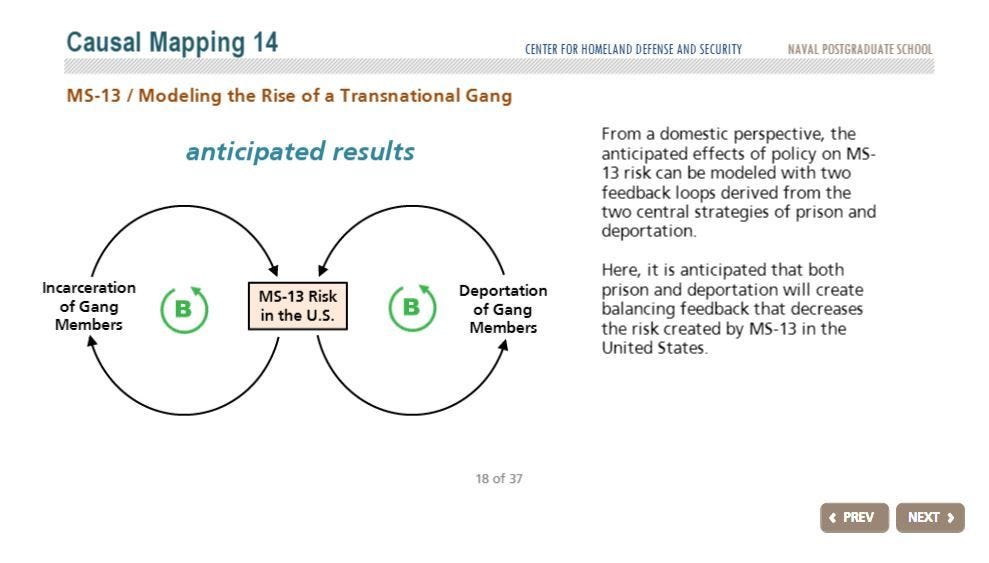Introduction to Systems Thinking Self-Study Course at the Center for Homeland Defense and Security: Update

Background
In the summer 2017 Wendy Walsh, FEMA's Higher Education Program Manager, and I got in touch about creating an introduction to systems thinking self-study course for emergency management and homeland security practitioners. The objective was to create an online course that would introduce practitioners to systems thinking while directly connecting them to the related literature. In this way the course would serve an educational purpose while also becoming a resource.
A few weeks after our initial phone call we met in Santa Cruz while Wendy put on the region's collaborative engagement in Palo Alto and I served as the report writer. While we were out in California, we met with Jodi Stiles and Glen Woodburry at the Navalpost Graduate School (NPS) who agreed to house the course and move it from a Word document to its final online format.
Over two days, we created the design brief for the course that included flow and scope, modules, and a list of systems thinkers and concepts to include. Following our meeting on the West Coast, I spent the next year moving through all the systems thinking literature I could find to create a 160 pages of course content complete with sketches of animations to be used throughout the course.
During the summer of 2018, I began working with the NPS to create an early online version of the course. Now after a two year hiatus, the course is being revisited, restarted, and moving to its final online format in the coming months. I am very excited about course being completed and wanted to introduce the course and share updates about the last leg of its journey to the CHDS website.
The Why and What of Systems Thinking
Systems thinking was selected for a self-study course topic as it presents a mode of thought, vocabulary, knowledge base, and set of tools for working in environments characterized by constant change, uncertainty, and interrelated and interdependent fluctuating variables where actions do not reliably lead to expected outcomes. Identified as some of the same challenges facing emergency management and homeland security practitioners, a working literacy in systems thinking presented itself as an opportunity for gaining new understandings and methods for working with current and emerging issues.
As it is presented in the article "The Next Generation Core Competencies for Emergency Management Professionals" and corresponding handbook, systems literacy is presented as an avenue toward increased adaptability and aligning understanding with the current environment:
The emergency management professional sees the whole picture, particularly interrelationships and patterns of change. Systems literacy helps the emergency management professional synchronize their understanding and practice with the ongoing shift away from a linear and hierarchical human order to one that is characteristically dynamic, complex, and exponential. The focus of systems literacy is on interdependent relationships that produce reactions, changes, and adaptations over time. This scientific foundation provides the emergency management professional a deeper understanding of the present for developing future focused strategies that enable adaptation and the ability to thrive (Felmann-Jensen, Jensen, Maxwell Smith, Vigneaux, 2019, p.24).
Course Flow and Topics
The course begins by contrasting systems thinking with conventional thought. The course then explores the foundational notion of systems and their characteristics. This module puts in place understandings at the very core of systems thinking such as the dynamics of self-organization, emergence and concepts including boundaries, subsystems, suprasystems, and nonlinearity. With foundational understandings in place, the course then introduces systems thinking through the use of multiple authors. A constant throughout the course is the use of direct quotes to preserve the original meaning and provide a usable resource. In many places, such as the definition of systems thinking, multiple direct quotes from different authors are used to offer more than one perspective and provide a network of ideas from which meaning can emerge (Cilliers, 2010).
After three foundational modules, the course begins taking systems and systems thinking out of the abstract by applying them to the concept of risk. A visual systems thinking approach is then taken to modeling risk within a community. One of systems thinking's strengths is its ability to visualize complex problems through the use of diagrams like the one pictured below.
Visualizing complex problems such as increasing risk in a community allows for the building of a common understanding, gaining fresh perspective, and walking through the dynamics and variables of a problem in a tangible way. Moreover, systems visualizations help to engage with a problem as they exist as a fluid situations where interventions do not always produce expected results. Staying with the topic of using systems thinking as a visual tool, the next module uses system models to tell stories about problems where solutions began yielding unexpected results. From this, alternative solution pathways are illuminated.
The remaining three modules of the course explore other aspects of systems thinking including knowledge-based tools, tools for external applications, and adjoining narratives such as complex adaptive systems, the Cynefin Framework, and intersections of systems thinking and design thinking.
Wrap Up
This course has been a lot of fun to put together and I am excited to see the finish project. I am particularly happy about its alignment with the Next Generation Core Competencies for Emergency Management project as it can serve as a resource for building systems literacy. At the same time, the course also exists as a general resource for gaining alternative perspective, language, and new tools for dealing with messy, difficult, and expansive problems.
References
Cilliers, P. (2010). The boundaries of complexity, the limits of systems . International Council on Systems Engineering.
Feldmann-Jensen, S., Jensen, S., Sandy, M., & Vigneaux, G. (2019). The Next Generation Core Competencies for Emergency Management. Journal of Emergency Management, 17(1), 17-25. doi:10.5055/jem.2019.0393






